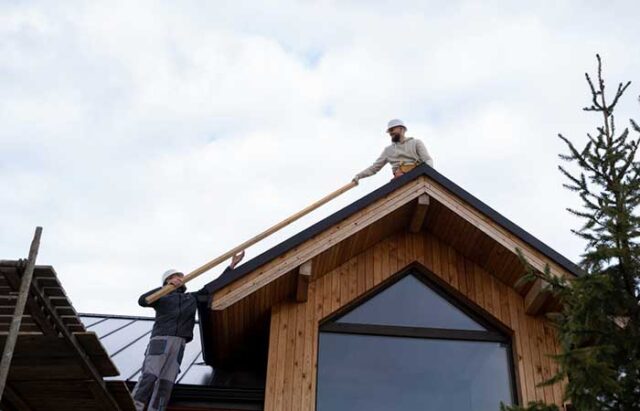Do you have a roof that isn’t in the best condition?
Neglecting your roof maintenance isn’t the best idea if you’re trying to maintain your house. Roofs play an important role in keeping your house in top condition. They prevent water, insects, and other things from getting into your house.
When you ignore your roof, it starts falling apart and increases the chance of getting damaged by severe weather conditions. You want to do anything to prevent this from happening.
Still unconvinced that you need to replace your roof? Continue reading and we’ll explain more how often to replace roof.
Considering Roofing Material
When considering roofing materials, it is important to understand that some roofing materials last longer than others. Quality products will often last twice as long as low-quality ones. Below will help you get a better understanding of the anticipated timeline for replacing the roof considering different material factors.
Asphalt Shingles
Asphalt shingles are one of the most common roofing materials available, and their life expectancy depends on the quality of the materials used and the climate in which they are installed. Generally, homeowners should expect to replace asphalt shingles every 20 to 25 years. An asphalt roof may need to be replaced sooner in areas that experience extreme weather conditions like storms or high winds.
Wood Shingles/Shakes
Generally, wooden shingles and shakes have a lifespan of 20-30 years. If your roof has lasted longer than that, it’s likely in need of replacement. Additionally, you should inspect your wooden roof regularly for signs of wear and tear.
If you spot any curling, cracking, or general aging of the shingles, it’s probably time to replace them. To ensure a full and proper replacement, contact a roofing professional or certified roofing services. They will be able to help you determine when it’s time to replace your wood shingles and shakes and provide you with the help needed to get the job done properly.
Metal Roofing
Typically, metal roofs have a lifespan of at least 20 to 50 years on average, depending on the type of metal and the climate. Additionally, a metal roof is more durable than other types of roofs and can last longer if properly maintained.
It’s important to inspect the roof monthly for damage and review the metal sheets for any signs of corrosion, rust, or other damage. This should be done throughout the lifespan of the roof, to maintain its integrity.
Additionally, regular maintenance should be done every two to five years, depending on the environment the roof is exposed to, such as extreme weather or high winds.
Slate Roofing
Slate roofing is a timeless classic and a great choice for the long-term homeowner. One of the key benefits of slate roofing is its durability – assuming it is installed and maintained properly, a slate roof can last for up to 200 years! That being said, regular roof maintenance is essential to maintain the longevity of a slate roof and ensure that it is performing optimally.
Depending on the environmental conditions, it is recommended to inspect and replace any weathered or damaged slates every 5-20 years. Furthermore, it is recommended to reseal and repair any defective slates every 2-3 years to prevent further damage. To protect an investment in a slate roof, it is important to have a professional roofer inspect the roof regularly to ensure its good condition.
Concrete or Clay Tiles
When it comes to concrete or clay tiles, a roof replacement should be done every 20 to 25 years. This is due to the tiles being exposed to extreme weather conditions and the elements over time. Additionally, a yearly inspection should be kept up as well as minor repairs when needed.
Depending on the climate and condition of the roof, it may be necessary for a replacement sooner or for additional protective layers such as sealant to be added. Keeping tabs on the condition of the roof can extend the life of the roof and prevent unexpected repairs in the future.
Synthetic Roofing Materials
Synthetic roofing materials offer homeowners numerous advantages, such as affordability, durability, and aesthetics. However, if not properly installed or maintained, they could quickly deteriorate leaving your home exposed to the elements.
Synthetic roofs typically last between 15 and 30 years; however, this duration can be extended with preventive maintenance and proper installation. The most important factor in determining replacement frequency is the existing weather conditions in your area.
Additionally, inspecting the roof at least twice annually and keeping up with maintenance such as cleaning and repairs, can further extend the life of your synthetic roof. Taking all these factors into consideration, most synthetic roofs should be replaced about every 15-30 years.
Natural and Synthetic Cedar Shake
Cedar shake roofs tend to wear out much faster than other types of roofing. It should be replaced at least every 20 years unless specified otherwise. Certain types of synthetic cedar shake can boast longer lifespans of up to 30 years depending on the manufacturer.
It is also important to inspect one’s roof annually. This is because cedar shake roofs tend to pick up moss, algae, and other forms of debris that damage the material over time. In addition, strong winds can easily peel, tear, or blow away entire pieces, necessitating a prompt roof repair or complete replacement depending on the extent of the damage.
Flat Roofs (Built-Up, EPDM, TPO)
Different roof types have different replacement needs. Flat roofs, built-up roofs, EPDM roofs, and TPO roofs are relatively common and each has unique considerations for replacement. Flat roofs should be inspected every 4 to 5 years and replaced as needed.
Built-up roofs typically last between 20 to 25 years and should be replaced when they begin to show signs of damage. EPDM roofs last up to 25 or 30 years and can be replaced before then if signs of aging or damage occur. TPO roofs last up to 20 years and should be inspected regularly for signs of wear or damage.
Considering Installation Quality
The quality of the installation is vital for the roof to protect your home from the elements, as improper installation can seriously decrease the lifespan of the roof. As a homeowner, the quality of the installation should be closely inspected and evaluated. If there are any signs of improper installation, then the roof should be replaced by a qualified professional, as soon as possible.
Regular inspection and maintenance can greatly increase the lifespan of a roof, and help to keep it in good condition. With proper maintenance, a roof should be able to last for 15 to 20 years, depending on the quality of installation, and the materials used.
Considering Ventilation
Proper attic ventilation is essential for lowering the temperature in the attic and thereby extending the life of the roof. If the attic is not properly ventilated, the heat and moisture can cause premature aging and warping of the shingles. For adequate ventilation, install intake and exhaust vents on your roof.
Intake vents such as soffits, vents, and turbine vents bring fresh air into the attic. Exhaust vents such as gable, roof ridge, and turbine vents allow the hot air to escape.
Add additional ventilation if necessary. With correct ventilation, roofs typically last between 20 to 30 years. This then still depends on the material.
Considering Maintenance
Generally speaking, the roofs of moderately-built homes should be replaced after every 20 to 25 years, although in areas with extreme weather conditions, the life of a roof may be shortened. If shingles need frequent repairs or if granules are starting to form loose on the roof’s surface, it’s a sign that the roof is near the end of its life.
It’s also smart to inspect a roof for signs of damaged or missing shingles after severe weather or after a fallen tree or branch. If a roof has any severe damage, it’s wise to replace it rather than attempt to repair it.
Considering Solar Panel Installation
When qualifying for solar panels, it is important to first determine the condition of your home’s roof. A roof should be replaced every 10-20 years, depending on the types of shingles and the climate in which you live. Signs that your roof might need to be replaced soon include:
- missing
- cracked
- warped shingles
- discolored spots
- leakages indoors
By replacing your roof regularly, you can ensure that your solar panel installation will be successful and beneficial for you. Regular maintenance and replacement of your roof will also allow your solar panels to operate efficiently by preventing any damage to the solar system or your home.
Additionally, when replacing a roof, you may be able to take advantage of tax credits and lower electricity bills. Therefore, it is important to stay on top of the roof replacement schedule to ensure the best results for your solar panel installation.
Know How Often to Replace Roof
Replacing your roof is a major undertaking, but it’s also important to know how often to replace roof. As long as you’re vigilant in watching for signs of wear and tear every few years, you can avoid any major issues.
So keep a watchful eye and don’t hesitate to contact a qualified roofer if you have any questions. Act now to make sure your roof is in top shape and your home is safe and secure!
If you want to read more helpful topics like this, visit our main blog.


































